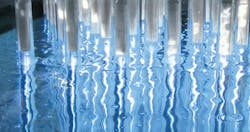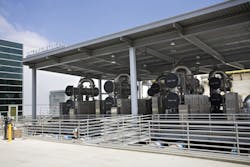Historically suffering from failing water treatment infrastructure, Colombia has had to embrace change. A look into the country's first open channel UV system for municipal wastewater in Tolu and efforts from global OEMs to change a reliance on chemical treatment across Latin America.
Change is on the horizon for Colombia's wastewater sector. As reported in the June-July edition of Water & Wastewater International (WWi), the country's new Bello wastewater treatment plant (WWTP) will have a capacity of 5 m3/second. Once complete, the Bello WWTP will end up servicing more than three million inhabitants and cover 95% of water discharged in the Medellin River.
It is hoped the US$347 million project from Spanish firm Acciona Agua will change the perception of public-private partnerships. More importantly, if successful, it could help plot a modern, state-of-the-art wastewater facility on a landscape usually accustomed to failing facilities plagued with structural problems.
Such lagging infrastructure was flagged up in February 2013 when a technical report published by the Colombian Superintendence of Public Works (Superservicios) found that 89 plants investigated were not operating.
The regulator inspected 333 systems – 59% of the 562 installed across 480 municipalities - in compliance with the country's National Development Plan 2010 to 2014. Problems found included an inability to meet treatment standards, lack of awareness of operation protocols, lack of maintenance and susceptibility to natural disasters.
A chemical disinfection market
With chlorine and chemical based disinfection widely used in municipalities across Colombia and Latin America, ultraviolet treatment (UV) is still seen as a "young" technology.
"Currently many water and wastewater treatment designs are based on long established technologies, primarily because engineering contractors here tend not use or specify 'younger' technologies – despite the fact that they are proven, evidence-based solutions," Juan Contreras, projects manager for Xylem Colombia tells WWi magazine.
Others believe the slow growth can also be attributed to perceived cost and required operating expertise.
Professor Joel Ducoste, member of the board for the International Ultraviolet Association (IUVA) and from North Carolina State University, says: "In terms of why UV hasn't really penetrated the Latin American market, it might stem from the fact that it's a more energy intensive technology, so there would be more cost to it and it requires more care in terms of operation and maintenance…UV technologies require a different skill set in terms of operation. It's not very complicated but does require a different level of skills from the operators."
Speaking to WWi magazine, Wayne Lem, municipal wastewater market manager for Trojan Technologies, adds: "Colombia currently has relatively weak enforcement of regulations when it comes to disinfection of municipal wastewaters. As such, there are challenges in the market for adopting UV for disinfection. This is being addressed by educating key stakeholders on how UV technology works and the benefits it has over chemical disinfection."
Odour issues in Tolu and UV solution
Public water supply and safety is critical globally and even more so when it comes to tourist destinations and maintaining the wellbeing of visitors. Colombia is one of a handful of popular Latin America destinations that has the tourist dollar income to protect.
One region heavily dependent on tourism is Tolu, known as the jewel in the crown along the east coastline. In this respect, the region has to make sure its water and wastewater treatment is up to scratch so visitors will return and provide repeated business.
However, the area in the past faced challenges with odour from its water treatment. When the current lagoons discharge wastewater it travels near to where the local population is living, so any unpleasant odours left from treatment potentially contaminates the surrounding area, including the sea. As a result, many habitants living near to the discharge zone complained about unpleasant odors, which were amplified during warm weather spells.
Therefore the announcement in summer 2013 of the country's first UV installation for municipal use in Tolu can be seen as an important one.
First open channel system
Water treatment firm Xylem secured a contract to install a secondary wastewater treatment solution for the Tolu Municipality. One of the first wastewater treatment systems to use UV disinfection in Colombia, the supplied solution will have a 400 square meter footprint and will replace traditional lagoons which have a 15,000 square metre footprint.
Whereas closed UV systems for industrial applications have been more common in Colombia, this particular UV solution from Xylem is the first to be installed in an open channel in the country.
Supplied equipment as part of the package will include an aeration system, decanters, blowers, monitoring, controls and instrumentation. Primary treated water coming from Xylem's Sanitaire ICEAS is transported to an open channel within which the Wedeco TAK UV system is installed. The disinfection process is then carried out by UV amalgam lamps.
Speaking to WWi, Contreas says: "UV destroys contaminates within seconds where chlorine needs an extended contact time to meet disinfection regulations. Chlorination systems also have potential health and environmental risks that require additional handling and processing to protect workers and the environment."
Meeting BOD and TSS regulations
Local regulations require effluent quality of 50 milligrams per litre Biological Oxygen Demand (BOD) and 22 milligrams per litre Total Suspended Solids (TSS). The supplied Xylem Sanitaire ICEAS solution will achieve effluent quality of less than 10 milligrams per litre BOD and TSS.
Boasting a reduced footprint and an operational cost saving of 11%, this raises the question of why has it taken so long for UV technology to be used?
"While UV is used in a limited number of industrial applications locally, it is an unknown technology in municipal circles – chlorine or chemical based disinfection is widely used," says Contreas.
"However, we succeeded in conveying the many benefits of UV technology – including the fact that it is environmentally sound and that it provides for the potential reuse of wastewater - to the Tolu municipality after developing a good working relationship with them."
Brazil breakthrough
Yet Xylem is not the only major player seeing opportunity south of the US. At the end of 2011 Canadian firm Trojan Technologies was awarded a US$600,000 contract to supply UV systems to four wastewater plants in the state of Espirito Santo, Brazil. Collectively the plants will treat 121,000 m3/day of wastewater.
It should be noted that at the time, Trojan could also claim that it supplied units into the largest UV wastewater treatment installation in Latin America.
The Curitiba plant, located in the southern Brazilian state of Parana, treats up to 136,000 m3/day. Since then the company has secured a US$1 million UV project in the continent but didn't disclose any further details.
While Lem admits that the region has not been without its challenges "there have been a few installations not operational or abandoned for various reasons including closure of wastewater treatment plants", Trojan is growing its installation base.
The Canadian company has 250 UV installations in Latin America treating a total of 750,000 m3/day of water/wastewater. Although less than 10% of the company's global business comes from the continent, it believes the market is set for growth.
"Disinfection to safeguard public health typically requires a regulatory driver," says Trojan's Lem, before adding: "We believe UV has a very bright future in Latin America for water and wastewater disinfection."
UV's future in Latin America
Xylem's Colombia projects manager is optimistic about the future of UV in the continent.
"We see many opportunities for business growth in Latin America, not just in the municipal market but also in the industrial sector," he says. "Once it is in operation it will be easier for consultants, other municipalities and the community in general to experience and understand the benefits of UV technology."
The IUVA's Professor Ducoste believes regulation will be the key driver. "It's more of a regulatory driver than a cost driver," he says.
Legislation in the US, he adds, makes it challenging for some chemical disinfections to be used due to apparent disinfection by-products. Because of this UV is being seen as a "go-to" technology to achieve adequate disinfection with no known by-products, he says. Technology evolution will also help level the playing field in the future when it comes to competing with popular chlorine treatment.
Process Explanation: UV light disinfectionUltraviolet light is energy-rich light with a wavelength of 200 – 400 nanometres (nm). The intensive UVC radiation, most strongly in the wavelength range of 254 nm, reaches the microorganisms and impacts directly on their DNA. By changing the DNA the cell division of the microorganism is interrupted – it can no longer reproduce itself and thus loses its pathogenic effect. UV technology manufacturers claim it is possible to destroy more than 99.99% of all pathogens within seconds. The light necessary for UV disinfection is generated in special UV lamps. A watertight tube made of quartz glass which allows the UV light to pass through surrounds each lamp. The liquid to be disinfected runs past the quartz tubing, being irradiated by the UV light. The number of UV lamps employed vary according to amount, flow rate and transmittance of the medium. Ultraviolet light is also suitable for oxidation and there-fore for the reduction of undesirable substances in water. For example, UV light with a wavelength of 185 nm oxidizes hydrocarbons, chlorine, NDMA and reduces TOC values. In combination with ozone and peroxide UV-light can additionally be used for advanced oxidation processes (AOP) for degradation of persistent pollutants from drinking water or wastewater. |
"The cost of UV will come down significantly," he says. "There is a lot of work being done in developing LEDs. They have already transformed the visible light industry by providing a long-lasting, low cost, low energy light source.
"This is already making its way into the UV wavelength. So at some point it is going to be cost neutral – there will be very little difference between chemical disinfectants and some of the new [UV] technologies because of the cost of the sources. The cost will come down dramatically and technology will last longer, reducing the O&M costs as well."
Closing remarks
The Superservicios report may have flagged up Colombia's poor performing facilities but this might have not been such a bad thing. Making headlines around the world, attention has been drawn on the country's lagging water sector.
This might have given Colombia the necessary motivate to change, improve and look to its Latin American siblings such as Brazil – hosts of the Rio 2016 Olympic Games and 2014 FIFA World Cup respectively, for inspiration.
Should the Tolu installation catalyze other municipalities to adopt UV over chemical treatment in Colombia, then the doors could open to the other global suppliers. One thing is for sure: the move from chemical to UV will not be a quick one in countries like Colombia.
Tom Freyberg is chief editor of WWi magazine. For more information on this article, please contact: [email protected]
About the Author

Tom Freyberg
Tom Freyberg is an experienced environmental journalist, having worked across a variety of business-to-business titles. Since joining Pennwell in 2010, he has been influential in developing international partnerships for the water brand and has overseen digital developments, including 360 degree video case studies. He has interviewed high level figures, including NYSE CEO’s and Environmental Ministers. A known figure in the global water industry, Tom has chaired and spoken at conferences around the world, from Helsinki, to London and Singapore. An English graduate from Exeter University, Tom completed his PMA journalism training in London.




